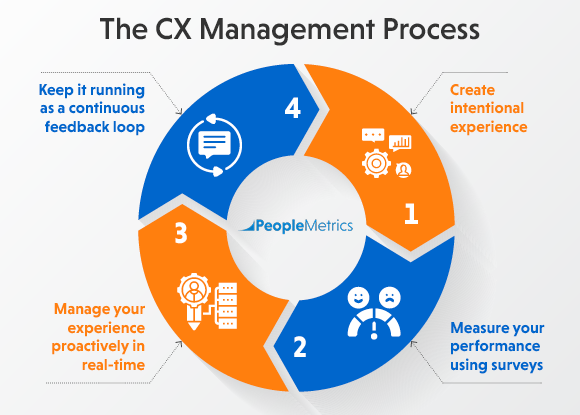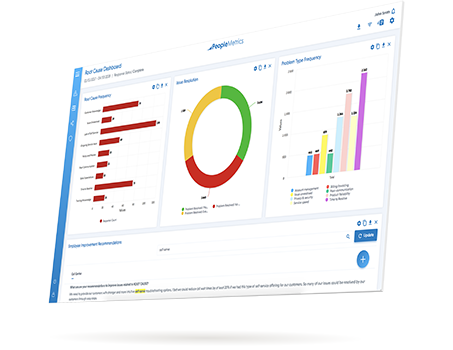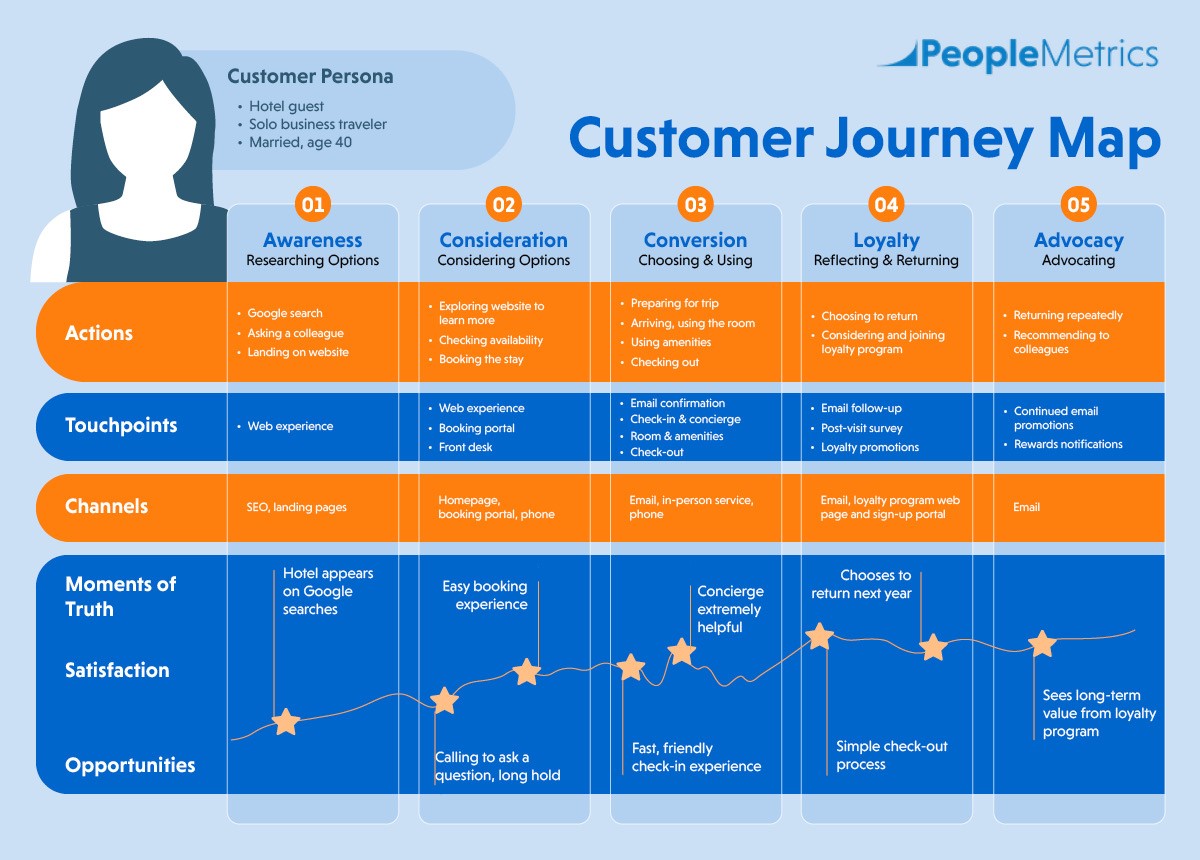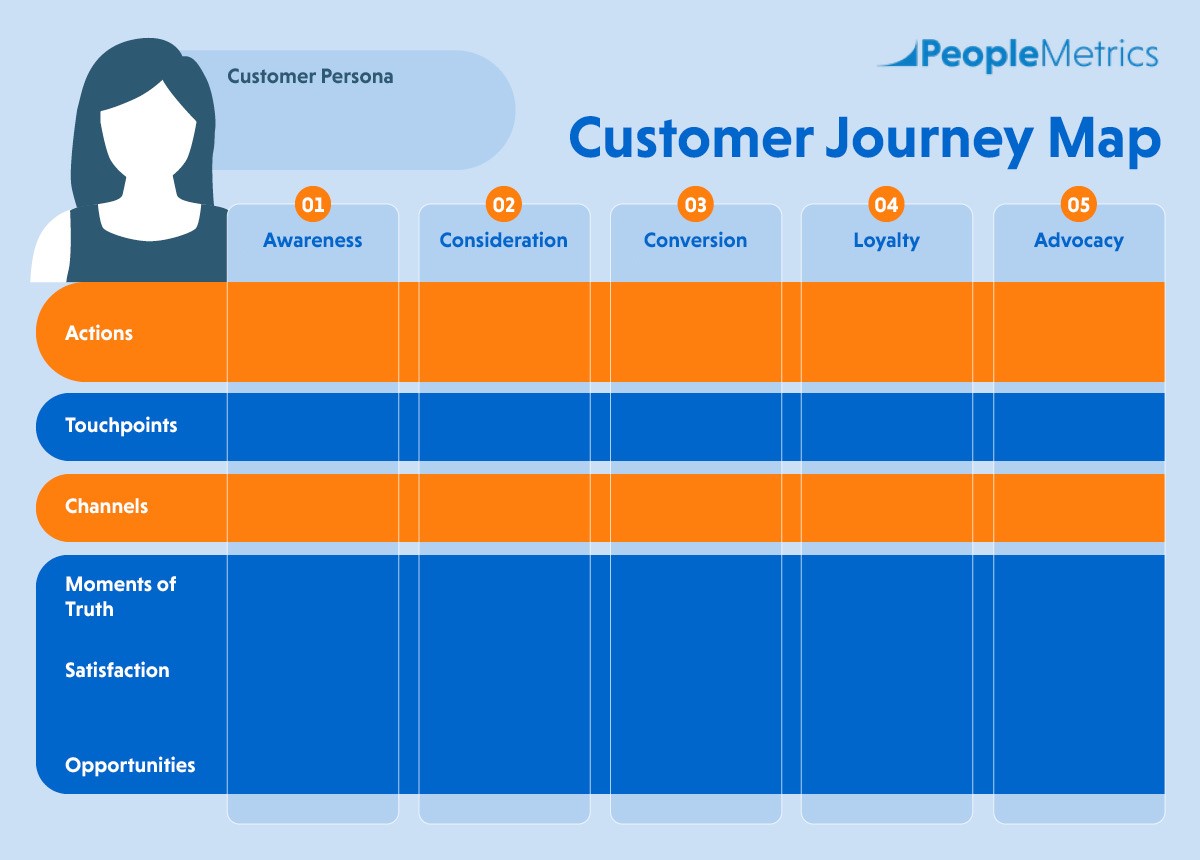Customer journey mapping can make the crucial difference between driving business success and seeing flagging customer satisfaction, retention rates, and revenue.
It's no coincidence that we frequently return to the businesses that offer us great experiences. Your favorite restaurant, an eCommerce site you frequently buy from, a hotel that you've visited several times, a professional vendor that your business relies on—if it's easy, fast, and enjoyable to engage with them, they've almost certainly put careful thought into their customer experiences.
Creating an amazing customer experience (CX) is an intentional process. Customer journey mapping is a foundational part of that process.
This introductory guide will give you everything you need to know to start mapping your own customer journeys and driving serious CX improvements. Here's what we'll cover:
- Journey Mapping Fundamentals
- Customer Journey Map Template
- How to Read a Customer Journey Map
- How to Create a Customer Journey Map
- How to Use a Customer Journey Map
- How to Improve Your Customer Journey Maps
Customer Journey Mapping: The Fundamentals
Let's start by reviewing the basics of customer journey mapping and why it's such a valuable practice for your business.
What's a customer journey map?
A customer journey map is a visual or multimedia representation of all the touchpoints that a customer has with your business over the course of your relationship.
The purpose of journey mapping is to identify and illustrate the connections between all of the interactions that lead up to particular outcomes. This then helps your business more intentionally and effectively design and manage customer experiences over time.
Journey maps are typically created for specific customer segments or personas, but they're very flexible tools. You might create a set of journey maps tailored to specific outcomes and timeframes—for instance purchasing a particular product for the first time or becoming a long-term brand advocate.
What are the benefits of journey mapping?
Customer journey mapping brings several key benefits:
- Deeper understanding of your customers
- Easy identification of operational inefficiencies
- Breaking apart of internal silos that prevent progress
- Discovery of new opportunities for improvement and differentiation
The process of customer journey mapping gives you deeper empathy and insight into what a customer goes through to interact with your company. This leads to more intentional, higher-quality experiences and deepened emotional connections.
In terms of concrete business impact, journey mapping can help you drive significant results across the entire customer lifecycle, from acquisition to retention. Not to mention, you'll have an outright competitive advantage above businesses that leave customer experience to chance.
What types of businesses use customer journey maps?
All types of businesses use customer journey maps to better understand their customers and drive improvements.
The underlying idea is that your customers (whether you serve consumers or other organizations) will judge their experience with your company regardless of how intentionally you've prioritized their journeys. Leaving their experience to chance is never wise—there are always steps you can take to simplify the customer's experience, anticipate their needs, or simply go above and beyond.
These streamlined and differentiated experiences are what bring customers and clients back (in any B2B, B2C, broad, or niche context), and journey mapping is how you create and manage them.
What is customer experience, and how does it relate to mapping?
Customer experience (CX) is the concept that all of the interactions a customer has with your business shape their perception and connection to it, which influences their short- and long-term buying decisions. Explore our complete introduction to CX to learn more about this field.
Proactively managing and improving your CX inherently requires careful thought about your interactions, touchpoints, and impressions with customers. This is where customer journey mapping comes in.
Journey maps are tools that should anchor and inform your CX strategies. Once you have an effective CX and customer listening process in place, you'll also be able to continually refine your journey maps as you learn more about customers' experiences and opinions.
This is particularly important for many businesses today. In today's digital environment, customers may have many more touchpoints with your business than in the past—in-store visits, website visits, demos, call centers, online help desks, and more. Journey mapping gives you the framework to effectively manage all of those channels and touchpoints cohesively.
Customer Journey Map Template
We'll walk through an example customer journey map to see these concepts in action. Let's say you run a hotel and want to better understand and improve the experience that you're offering to a specific segment of customers. Your journey map might look like this:
[Click on the image to expand it and take a closer look.]
How to Read this Customer Journey Map
Let's explore the various elements of this customer journey map in closer detail.
Customer Persona
Dedicate space on your journey map to make note of the specific customer persona that it's about. This will help ensure your journey map stays focused on that segment's particular wants and needs.
A quick note on creating personas: To create customer personas, try grouping your existing customers into distinct segments based on demographic information, their history with your business, and their value to your business. Then, create fictitious characters that fit into each segment and flesh out the details of their likes, dislikes, family status, income, and more (through a mix of your data and your imagination).
In this hotel example, the sample customer is a frequent solo business traveler, married, age 40, in town for a professional conference. She likes uncomplicated check-in experiences, easy access to transportation, quiet nights, and convenient food options. She dislikes late-night noise and when problems require the help of multiple people to resolve.
Stages of the Customer Journey
The customer journey is traditionally broken down into five key stages:
- Awareness - The customer identifies their need and researches options. They encounter your business through some form of advertising, marketing, or word of mouth.
- Consideration - The customer is learning more about your product/service and weighing whether or not to choose your business.
- Conversion - The customer makes the choice to go with your product or service over another. They'll then directly experience the product or service.
- Loyalty - The customer reflects on their experience, uses ongoing support, and/or chooses to use your business again.
- Advocacy - The customer is retained and satisfied with their experiences, and they recommend your business to peers—the ideal final outcome.
Remember that these stages are a generally useful framework, not an exact pattern that will work for every business model or type of customer. For this reason, it can be helpful to define your journey stages in more specific, customer-centric terms—what they're learning, doing, or deciding in the periods of time before and after converting.
Our hotel example does generally follow this traditional framework, but we might instead adjust the stages slightly as:
- Researching options
- Considering options
- Choosing and using
- Reflecting and returning
- Advocating
These are fairly small changes, but they help give our customer journey map an added level of specificity.
Actions
This section details the specific actions that the customer is taking during that stage of the journey.
Touchpoints
These are the points during each stage of the customer's journey in which they engage directly with your business. They're interactions that you can directly control in terms of ease, usefulness, and quality.
Metrics
This section documents the specific metrics and key performance indicators (KPIs) that your business can use to measure success. These will be different at the different stages of the journey and depending on how you're interacting with the customer. For instance:
- Success at the Awareness stage hinges on the hotel's marketing effectiveness, so it's measured in terms of search engine impressions, ad clickthrough rates, and site visits.
- Once the customer has converted, the hotel can measure impact through satisfaction surveys, in-person feedback, and add-on purchases.
- In the Loyalty stage and beyond, revenue generated from that customer segment, retention rates, lifetime values, and net promoter scores will be helpful.
Customer experience software is a useful tool for collecting direct feedback across the entire customer journey and driving real-time improvements—more on this below.
Channels
This section details the channels that are used to interact with the customer and to collect feedback and data on their experience.
Moments of Truth
Moments of truth are the interactions or points in the customer journey that, if they go poorly, will have serious negative consequences on the outcome. In other words, they're turning points in the customer relationship. An example might be someone failing to pick up the phone at the front desk when a hotel visitor calls down with an important request.
Understanding the moments of truth in your customer journeys is an essential part of improving the overall customer experience. CX management is built around identifying and optimizing these moments to ensure positive outcomes, so it's valuable to make note of them in your journey maps.
It can also be helpful to build customer journey maps around single moments of truth and the actions and decisions that occur before and after them. This allows you to zoom into the details without limiting yourself to a single interaction. Focusing on moments of truth makes it easier to prioritize improving the most impactful points in the customer journey and to create truly differentiated experiences.
Satisfaction Trajectory
This section charts the customer's overall emotional state and satisfaction as they go through the journey with your business.
As with moments of truth, continuously collecting feedback from customers allows you to refine your understanding of how customers feel at different points in the journey. The process of laying out an assumed trajectory and then testing and correcting it based on real customer data can be extremely valuable.
Opportunities
Use this section of a customer journey map to note the specific improvements you can make to improve customer satisfaction and outcomes.
Creating a Customer Journey Map
Next, let's review the general steps your team can follow to create a customer journey map. Download this blank customer journey map template to follow along:
- Determine your journey map's objectives and scope.
- Why are you creating a customer journey map? What do you want to learn or improve? Define these objectives and use them to anchor your process going forward.
- Additionally, determine the scope of your map—the entire journey or a specific moment of truth within that journey? You can zoom in and out based on what you're aiming to accomplish.
- Define your persona, their motivations, and goals.
- Who is the customer taking this journey? Dig into your data to learn more about this segment of your customer base and then get creative to flesh out the details. What are they hoping to accomplish? What will wow them? What will leave them dissatisfied?
- Break the journey down into discrete stages.
- Work with your team to walk through the customer's journey. What are the discrete stages that it could be broken into?
- As mentioned above, the traditional awareness-consideration-conversion-loyalty-advocacy framework is a helpful starting point, but don't be afraid to make adjustments based on your specific goals and scope. Be customer-centric, building your stages around what they're actually doing and accomplishing at each part of the journey.
- List all touchpoints and customer actions.
- Work through each stage of the journey and list the individual actions that the customer takes and the touchpoints/interactions that they have with your business along the way.
- Remember to consider both "frontstage" and "backstage" touchpoints, i.e. those in which the customer engages directly with your business and those that are purely internal but impact the customer experience.
- Compile the touchpoints into a coherent journey.
- Organize the touchpoints into a clear order. Note that not all of the touchpoints and actions you identify will necessarily be relevant to the objectives or final outcome of the journey and so might not be included.
- Take the time to carefully think through the journey as you organize them. Note the moments of truth or most critical pivot points in the journey.
- Test your customer journey and make changes.
- Work with your team to walk through the journey step-by-step, and compare thoughts and impressions. You might also ask team members to create their own versions of journeys and identify moments of truth so that you can compare them together.
- Make adjustments based on your tests and discussions. Review the moments of truth you've identified, and use those to guide your CX improvement strategies going forward.
Additional Journey Mapping Considerations
Before you dive into creating your next (or first) customer journey map, there are a few additional considerations to keep in mind.
Namely, remember to be flexible and not to feel stuck with a single way of approaching or structuring your customer journeys.
Customer journeys are continuous and nonlinear, hence why they're difficult to fully capture in a beginning-to-end linear way. This is why journey maps are particularly useful for digging deeper into specific moments of truth that your customers encounter—a zoomed-in snapshot of elements you can design and control rather than a complex or overwhelming representation of the entire journey.
Additionally, remember that journeys can look very different for different types of businesses and customers.
A B2B firm selling enterprise-level software in lengthy buying processes will need to design and analyze journeys that are quite different from those designed for a restaurant. Services, both B2B and B2C, will follow unique journeys as well. The key is to remain flexible and customer-centric. Use the customer's actual experiences, needs, and decisions to guide your mapping process.
Using a Customer Journey Map
So you've created a new customer journey map—how do you start using it to drive business results and make improvements to your customer experience?
The most immediately useful outcome of journey mapping is that it helps you identify pain points and moments of truth in your current customer experience. These should then be prioritized in your ongoing CX efforts.
Here's an example: If you know that one of your critical touchpoints is the process of customers finding your business online and navigating to a specific page on your website, dig into how that experience is currently playing out for your customers.
Research your web visibility, website design, digital engagement metrics, and customer feedback to identify the hurdles they're encountering and the improvements that you could make. Check out your competitors' websites and how they guide visitors towards relevant information.
As you pursue new CX improvements over time, keep refining your journey maps. New moments of truth might emerge as you learn more about your customers or as you update your processes. Share your maps internally and educate your teams on how their roles relate to customer outcomes. Treat them as living documents that can be continually referenced and updated to help you better prioritize the changes you make to your customer experience.
Most importantly, pay attention to data collection. Fresh data on the performance of your strategies is essential for making impactful improvements and ensuring the long-term value of your journey maps. We recommend focusing heavily on collecting the most directly helpful data you can—customer feedback.
Improving Your Journey Maps with Continuous Feedback
Just like journey mapping, continuously collecting customer feedback is an essential component of your broader customer listening and CX strategy.
Collecting feedback provides the data and input you need to guide your mapping process, both as you create new maps focused on specific journeys and as you update them over time. It generates insights to help you better understand customer emotions, motivations, and pain points. Feedback allows you to kickstart productive feedback loops at key points in the journey and drive continuous iterative improvements.

In other words, proactively and continuously collecting customer feedback will maximize the usefulness of your journey maps.
Plus, active feedback collection channels give you the immediate benefit of being able to improve individual customer experiences in real-time. This is particularly valuable for businesses seeking to improve high-impact CX, or the experiences of a small set of your highest-impact customers and clients.
Tools like PeopleMetrics make it possible to set up the collection channels and feedback loops that are necessary for effective CX management.

Through targeted surveys, intuitive reporting features, and comprehensive support, PeopleMetrics can help your business quickly get up and running with an advanced CX infrastructure and strategy.
Learn more about PeopleMetrics and the field of CX with these additional resources:
- What is Customer Experience? Complete Introduction to CX
- An Introduction to Building Customer Understanding
- Customer Satisfaction Software: Crash Course & Top Features
- How the Customer Feedback Management Process Works









%20(1).png)